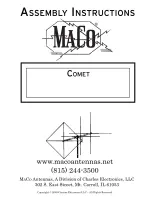
1. Thread a 300 to 75 Ohm matching transformer’s spade terminal ends
through the antenna’s strain-relief tab.
2. Slide the spade terminal ends around the antenna’s lead-in terminals
marked
CONNECT LEAD-IN HERE
. Secure them with the supplied
flat washers and large wing nuts.
3. Screw the cable’s F-connector onto the matching transformer. Then
slip the weatherboot over the connection.
Note:
If you use a cable without a weatherboot, cover the connection
with weatherproof tape.
UNFOLDING THE ANTENNA ELEMENTS
1. If your antenna has a UHF dipole, pull the dipole’s two halves from the
main boom until they lock into place. Place each unattached end over
each of the antenna’s lead-in terminals .
Note:
Both sections of the isolation network should remain parallel to
the main boom.
2. If your antenna has a UHF wing boom, hold each wing boom and turn
its elements until they snap squarely into place.
3. Fold out the wing booms and secure them into position with the two
supplied 1¼-inch screws and wing nuts.
4. Hold the main boom’s elements near the pivot points and pull them away
from the boom until they snap into the locking support brackets.
Note:
You may wait to unfold the elements until you get the antenna up on the
roof. Do not pull the elements near their outer ends or you could damage them.
Once the elements are locked into position, do not attempt to unlock them.
CONNECTING LEAD-IN CABLE TO THE ANTENNA
We recommend RG-6 cable, and if you prepare your own cable, a quality
F-connector.
Note:
If you prepare your own cable, slide a 300 to 75 Ohm matching trans-
former’s weather boot onto the cable before you attach the F-connector.
Main Boom
3. If your antenna has triangle shaped delta wings on some of the elements,
unfold each pair of them so that one wing points upward and one wing
points downward.
ATTACHING TO THE MAST
We recommend you get the help of another person before you put up the
mast or attach your antenna to it. How you set up your mast depends on
your specific installation.
Refer to the Consumer Product Safety Commission information on pages 3
and 4 of this manual for recommended methods.
1. With the antenna’s locking support brackets on top of the boom, slide
the antenna’s mast clamp assembly or assemblies over the top of the
mast. If your antenna has a support boom, make sure the main boom
is on top and the element’s support brackets are on top.
2. Tighten the mast clamp assembly’s lock nuts to hold the antenna in place.
Do not overtighten the lock nuts.
Caution:
The crossover wires must not touch the antenna boom, the
mast, or each other. If necessary, carefully bend the crossover wires to
provide at least 1/2 inch of clearance.
3. Set up the mast, then rotate it so the antenna’s shortest elements point
toward the stations you want to receive.
ROUTING THE CABLE TO YOUR RECEIVER
Use plastic tape to secure the coaxial cable to the mast at about 3-foot
intervals.
Use coaxial nail clips every few feet to secure the cable between the
mast and where the cable enters the house.
Use a 75-ohm grounding block at the point where the coaxial cable
enters the house. Read the Consumer Product Safety Commission
information for grounding instructions.
Use a drip-loop before the cable is routed into the house.
Use a wall-through tube to neatly route the coaxial cable through the
wall.
Main
Support
Brackets
Support Boom
Delta Wings
Delta Wings
2






















